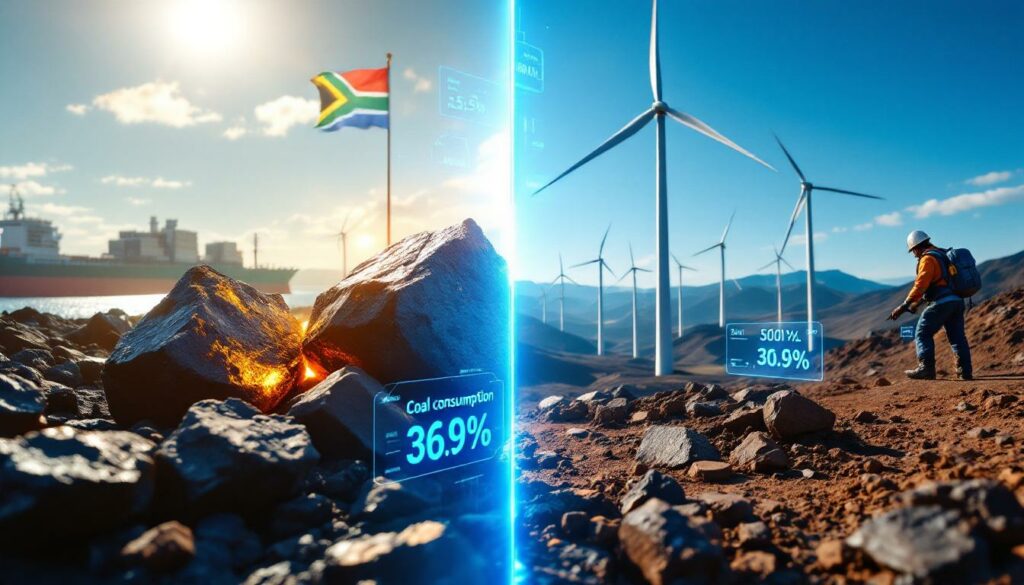How Are Iron Ore Exports Performing Despite Global Market Challenges?
Kumba Iron Ore has demonstrated remarkable resilience in the global marketplace, achieving a 3% increase in iron ore sales volumes compared to the previous year, despite challenging international market conditions. This growth comes as a direct result of effective collaboration between the public and private sectors, illustrating how strategic partnerships can drive export performance even in difficult times.
The success story behind Kumba's export growth centers on two key initiatives: the iron-ore corridor programme and the iron-ore user forum. These collaborative frameworks have focused on maintaining and improving South Africa's logistics infrastructure, a critical component in ensuring the steady flow of minerals to international markets.
"Customers are realizing now that the quality of our iron-ore is worth paying 8% more for," notes mining industry analyst Martin Creamer of Mining Weekly, highlighting the premium pricing Kumba has secured in global markets.
This premium pricing represents a significant achievement for South African mining exports. Kumba's iron ore commands prices 8% above global benchmark rates, reflecting the internationally recognized quality of their product. This price advantage translates directly to improved revenue streams and demonstrates the value of quality-focused mining operations in competitive global markets.
Public-Private Collaboration Boosts Export Performance
The successful public-private partnerships underpinning Kumba's export growth provide a blueprint for other sectors seeking to overcome logistics challenges. By bringing together government agencies and private industry expertise, these initiatives have addressed infrastructural bottlenecks that previously limited export potential.
The iron-ore corridor programme specifically targets the efficient movement of minerals from mining operations to port facilities, optimizing transportation networks and reducing delays. Similarly, the iron-ore user forum creates a platform for stakeholders to identify and resolve issues affecting the export chain, ensuring continuous improvement in logistics performance.
These collaborative efforts highlight the importance of aligned objectives between government and industry players in maximizing South Africa's export potential. The resulting logistics improvements have directly contributed to Kumba's ability to increase export volumes despite global market headwinds.
Quality Improvements Set to Enhance Future Value
Looking ahead, Kumba is investing in technological advancements designed to further enhance the quality of its iron ore exports. The company is expanding its ultra-high dense media separation (UHDMS) capabilities at Northern Cape operations, representing a significant technological investment in quality enhancement.
UHDMS technology allows for more precise separation of iron ore from waste material, resulting in higher-grade products that command premium prices in international markets. This technological advancement addresses the growing demand for high-quality iron ore, particularly from steel manufacturers seeking to improve efficiency and reduce environmental impacts.
By focusing on quality enhancements, Kumba is positioning itself strategically in the global marketplace. The company's investment in UHDMS technology demonstrates a forward-thinking approach that recognizes the increasing importance of product quality in maintaining and expanding market share.
As global iron ore price trends continue to face supply challenges and price volatility, Kumba's emphasis on quality improvement provides a competitive edge that supports sustained export growth. This strategy aligns with broader trends in the mining sector, where value-added processing increasingly determines market success.
How Is Seriti Resources Balancing Coal Mining and Renewable Energy?
In the heart of South Africa's energy transition debate, Seriti Resources is pioneering a pragmatic dual approach that balances traditional coal mining with renewable energy development. Under the leadership of CEO Mike Teke, the company is simultaneously commissioning its fourth wind turbine in Mpumalanga province while ramping up operations at a brand new coal mine.
This strategic balancing act recognizes both the continued importance of coal to South Africa's energy security and the growing imperative to develop renewable energy sources. Rather than positioning coal and renewables as competing alternatives, Seriti has embraced a complementary approach that maximizes the benefits of both energy sources.
"Mike Teke deserves a big pat on the back for getting the best out of both worlds — coal and wind," observes Martin Creamer, acknowledging the innovative nature of Seriti's dual-track strategy.
The company's approach reflects a nuanced understanding of South Africa's energy challenges, where the immediate need for reliable electricity must be balanced with longer-term sustainability goals. By investing in both sectors simultaneously, Seriti is helping to ensure energy security while gradually transitioning toward a more diversified energy portfolio.
Strategic Energy Diversification in Mpumalanga
Seriti's energy diversification strategy in Mpumalanga province represents a thoughtful response to the challenges of energy transition in coal-dependent regions. Rather than abruptly shifting away from coal, the company is gradually building renewable capacity alongside its traditional mining operations.
The location of Seriti's renewable energy projects in Mpumalanga is particularly significant. This province has historically been South Africa's coal heartland, with communities and infrastructure built around mining operations. By developing wind energy in the same region, Seriti is helping to create new economic opportunities in mining without abandoning existing communities.
This approach recognizes the finite nature of coal resources while harnessing the infinite potential of renewable energy sources like wind. It also addresses the practical realities of energy transition, where existing grid infrastructure and skilled workforce can be leveraged to support both traditional and emerging energy technologies.
Employment Benefits of the Dual Approach
One of the most compelling aspects of Seriti's dual energy strategy is its positive impact on employment in the Mpumalanga region. While renewable energy operations typically employ fewer workers than traditional mining on a per-megawatt basis, Seriti's expansion of coal mining alongside renewable development helps maintain and potentially grow overall employment.
The new coal mine creates immediate jobs in mining operations, maintenance, and support services, providing continued employment opportunities for workers with mining skills and experience. Simultaneously, the wind energy projects create positions in construction, maintenance, and technical operations, helping to develop new skills in the local workforce.
This balanced approach addresses one of the central challenges of energy transition outlook: ensuring that the shift to cleaner energy doesn't come at the expense of jobs and livelihoods. By creating employment opportunities in both sectors, Seriti is demonstrating how energy transition can be managed in ways that support rather than undermine local economies.
Seriti Green: Dedicated Focus on Renewable Energy
Recognizing the strategic importance of renewable energy to its future, Seriti has established a specialized division called Seriti Green focused specifically on renewable energy development. This organizational structure demonstrates the company's long-term commitment to energy transition while maintaining its core coal mining operations.
Seriti Green serves as the company's platform for identifying, developing, and operating renewable energy projects, beginning with wind but potentially expanding to other technologies like solar. This dedicated division allows Seriti to build specialized expertise in renewable energy while maintaining its traditional mining operations.
The establishment of Seriti Green also signals to investors, regulators, and communities that the company's renewable energy investments are not merely token gestures but part of a strategic vision for the future. This institutional commitment helps to build credibility for Seriti's dual-track approach and positions the company for leadership in South Africa's evolving energy landscape.
What Impact Are Data Centers Having on Global Energy Demand?
The global proliferation of data centers is emerging as a significant driver of electricity demand, creating new challenges and opportunities for energy providers worldwide. According to insights shared at the recent Coal & Energy Transition Day in Johannesburg, each new data center requires electricity equivalent to powering approximately 100,000 households – a staggering energy footprint that is reshaping global power markets.
This unprecedented demand for electricity is being driven by the explosive growth of digital services, cloud computing, and most recently, artificial intelligence applications. As businesses and consumers increasingly shift activities online, the physical infrastructure supporting these digital services requires ever-greater amounts of reliable electricity.
"Data centers are springing up like mushrooms… [They] require as much electricity as 100,000 homes," explained Vuslat Bayoglu, Managing Director of Menar, highlighting the scale of this energy challenge.
The energy intensity of data centers presents both challenges and opportunities for countries like South Africa, where reliable electricity supply has been a persistent concern. Understanding this growing demand is crucial for energy planning and infrastructure development decisions.
Unprecedented Power Requirements for Digital Infrastructure
The power requirements of modern data centers represent a step-change in electricity demand compared to traditional industrial and commercial uses. These facilities operate 24/7, requiring constant, uninterrupted power supplies to maintain services and protect sensitive equipment and data.
While individual servers have become more energy-efficient over time, the sheer scale of modern data centers means their total energy consumption continues to grow. A typical hyperscale data center can consume tens or even hundreds of megawatts of electricity – comparable to small cities in terms of power demand.
This enormous energy footprint extends beyond direct electricity consumption. Data centers also require substantial cooling systems to prevent equipment overheating, adding further to their energy requirements. In hot climates like South Africa's, cooling needs can represent up to 40% of a data center's total energy consumption.
The combined effect of processing power and cooling requirements makes data centers among the most energy-intensive facilities in the modern economy, creating significant challenges for electricity supply planning and grid management.
Global Proliferation of Data Centers
The rapid global expansion of data center infrastructure is a defining feature of the digital economy. As Vuslat Bayoglu noted, these facilities are "springing up like mushrooms" around the world, driven by growing demand for cloud services, content delivery networks, and data storage.
While South Africa may not be experiencing the same rate of data center development as some regions, the global trend is creating massive aggregate energy demand. Major technology companies like Microsoft, Amazon, and Google are building data centers across multiple continents, each requiring substantial power infrastructure.
This proliferation is accelerating with the growth of artificial intelligence applications, which require significant computing power for both training and operating AI models. The computational requirements of advanced AI systems can be orders of magnitude greater than traditional applications, driving demand for even larger and more power-hungry data centers.
The global nature of this trend means that even countries not directly hosting many data centers are affected by the resulting changes in energy markets, technology development, and infrastructure investment priorities.
High-Energy Era Demands Reliable Supply
The emergence of data-intensive technologies has ushered in what industry leaders are calling a "new high-energy era" with distinctive requirements for electricity supply. Unlike some applications that can tolerate occasional interruptions, data centers and AI systems demand extremely reliable power with minimal disruptions.
Representatives from Google have emphasized the critical importance of reliable electricity supply without blackouts or interruptions, particularly for artificial intelligence applications. Power disruptions can cause significant problems for AI systems, potentially corrupting data or disrupting complex computational processes.
This intolerance for power interruptions has significant implications for electricity system planning and operation. Grid reliability becomes even more critical, potentially driving investment in backup power systems, energy storage, and redundant supply arrangements.
For countries like South Africa, where electricity supply reliability has been challenged by infrastructure constraints, the high reliability demands of data centers create both opportunities and challenges. Meeting these reliability requirements could drive broader improvements in electricity system performance, benefiting all consumers, but also requires substantial investment and technical capability.
How Should South Africa Respond to Changing Energy Demands?
As South Africa navigates the complex landscape of changing energy demands, industry experts are advocating for a pragmatic, balanced approach that ensures both energy security and sustainable development. The discussions at the recent Coal & Energy Transition Day emphasized that South Africa's energy strategy must address immediate reliability concerns while gradually transitioning toward a more diversified and sustainable energy mix.
This balanced approach recognizes the unique challenges and opportunities facing South Africa, including its abundant coal resources, growing renewable potential, and pressing need for reliable electricity to support economic development. Rather than pursuing abrupt changes that might undermine stability, experts recommend a measured transition that maintains energy security while steadily reducing environmental impacts.
"South Africa needs a mixture of energies — renewables, solar, wind, coal-fired — to meet electricity demand," concluded industry experts at the Coal & Energy Transition Day, highlighting the importance of a diverse energy portfolio.
The path forward for South Africa involves careful planning, strategic investment, and thoughtful policy development to ensure that energy transitions support rather than hinder economic growth and social development.
Diversified Energy Portfolio Needed
Industry experts are unanimous in recommending that South Africa develop a diverse energy mix that includes renewables (solar and wind), coal-fired generation, and other viable energy sources. This portfolio approach aims to ensure adequate electricity supply to meet growing demands while managing the transition to cleaner energy sources.
A diversified energy portfolio offers several advantages for South Africa. It reduces reliance on any single fuel source, enhancing energy security by mitigating supply risks. It allows the country to capitalize on its abundant renewable resources, particularly solar and wind, while maintaining the reliability benefits of established generation technologies. And it creates flexibility to adapt to changing technologies, market conditions, and policy priorities over time.
The optimal mix will likely evolve as technologies develop and costs change. Solar and wind power costs have declined dramatically in recent years, making them increasingly competitive with conventional generation. However, their intermittent nature means they require complementary resources or storage to ensure reliable supply. Coal, despite its environmental challenges, provides dispatchable power that can help balance these renewable sources.
By pursuing a balanced portfolio rather than focusing exclusively on any single technology, South Africa can build an electricity system that meets both current and future needs while gradually transitioning toward lower-carbon options.
Energy Security as Economic Priority
The discussions at the Coal & Energy Transition Day emphasized that energy security must be a top priority for economic development. Without reliable electricity, South Africa risks missing opportunities in emerging industries and technologies that depend on consistent power supply.
The link between energy security and economic prosperity is particularly relevant given the growing energy demands of data centers and other digital infrastructure. As highlighted by industry experts, these facilities require not just substantial quantities of electricity but also exceptional reliability. Countries unable to provide this reliable supply risk being left behind in the digital economy.
Energy security concerns extend beyond the digital sector to encompass manufacturing, mining, and other industries that form the backbone of South Africa's economy. Businesses in these sectors rely on predictable, affordable electricity to maintain operations, create jobs, and compete in global markets.
By prioritizing energy security in policy decisions, South Africa can create a foundation for broader economic development and job creation. This approach recognizes that reliable electricity is not merely a convenience but an essential prerequisite for modern economic activity.
Balanced Transition Rather Than Abrupt Change
Energy experts are recommending a balanced approach to energy transition rather than an abrupt shift away from coal. This measured strategy recognizes the continued importance of coal to South Africa's energy security while gradually increasing the role of renewable energy sources.
This balanced approach has several practical advantages. It allows time for the development of renewable energy supply chains, workforce training, and supporting infrastructure, reducing transition costs and disruptions. It maintains reliability while new technologies are integrated into the electricity system. And it provides opportunities for communities currently dependent on coal mining to diversify their economies gradually rather than facing sudden economic shocks.
The experiences of Seriti Resources, with its parallel investments in coal mining and wind energy, demonstrate how this balanced approach can work in practice. By developing new energy sources alongside existing ones, companies and communities can manage transitions in ways that maintain employment and economic activity.
This measured approach aligns with global best practices for energy transition, where the pace of change is calibrated to maintain system reliability and social stability while steadily reducing environmental impacts over time.
Kumba and Seriti: Leading South Africa's Resource Future
The experiences of Kumba Iron Ore and Seriti Resources offer valuable insights into how South African resource companies can navigate changing global markets and energy landscapes. Both companies are demonstrating strategic approaches that balance immediate economic realities with longer-term transitions.
Kumba's focus on quality improvement and logistics collaboration has enabled it to increase iron ore exports despite challenging global conditions. By commanding premium prices for high-quality products and working effectively with public sector partners, the company is maximizing the value of South Africa's mineral resources.
Similarly, Seriti's dual investments in coal mining and wind energy provide a blueprint for balanced energy transition. Rather than abandoning traditional energy sources, the company is strategically developing renewable capabilities alongside its core business, creating a bridge to a more diversified energy future.
These complementary approaches—improving export logistics, developing renewable energy alongside traditional sources, and planning for increased energy demand—represent pragmatic responses to South Africa's economic and energy challenges. By following these examples, other companies and policymakers can help ensure that South Africa's resource wealth continues to support prosperity while gradually transitioning toward more sustainable practices.
As the global economy evolves and energy demands change, the ability to balance immediate needs with long-term transitions will be increasingly valuable. Companies like Kumba and Seriti are demonstrating how this balance can be achieved in practice, offering lessons for South Africa's broader economic development strategy.
The mining sector's future will depend increasingly on adapting to changing market demands and embracing electrification in mining operations, while also making strategic decisions based on iron ore forecast insights that help navigate market volatility.
Want to Capitalise on the Next Major Mineral Discovery?
Stay ahead of the market with Discovery Alert's proprietary Discovery IQ model, which provides instant notifications on significant ASX mineral discoveries, turning complex data into actionable insights. Understand why historic discoveries can generate substantial returns by visiting Discovery Alert's dedicated discoveries page and begin your 30-day free trial today.




